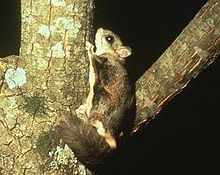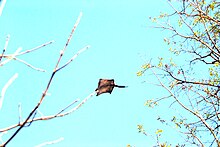Flying squirrel: Difference between revisions
m Reverted edits by 71.182.134.130 (talk) to last revision by ClueBot NG (HG) |
Tag: categories removed |
||
| Line 144: | Line 144: | ||
* {{Cite EB1911|wstitle=Flying-squirrel}} |
* {{Cite EB1911|wstitle=Flying-squirrel}} |
||
== External |
== External. |
||
{{Commons category|Pteromyini}} |
|||
* [http://www.nature.org/ourinitiatives/regions/northamerica/unitedstates/washington/explore/the-nature-conservancy-in-washington-flying-squirrels-in-the-spotlight.xml It's a Bird! It's a Plane! No, it's a Flying Squirrel!] — [[The Nature Conservancy]], March 7, 2011 |
|||
* [http://www.flyingsquirrels.com/ FlyingSquirrels.com] |
|||
* [http://animaldiversity.ummz.umich.edu/site/accounts/classification/Pteromyinae.html Animal Diversity Web: Pteromyinae], classification |
|||
{{S. Sciurinae2 nav}} |
|||
{{DEFAULTSORT:Flying Squirrel}} |
|||
[[Category:Squirrels]] |
|||
[[Category:Flying squirrels| ]] |
|||
[[Category:Pet rodents]] |
|||
[[Category:Gliding animals]] |
|||
{{Link GA|de}} |
|||
[[mr:शेकरू]] |
|||
Revision as of 18:45, 28 October 2013
| Flying squirrel Temporal range: Early Oligocene – Recent
| |
|---|---|

| |
| Northern flying squirrel (Glaucomys sabrinus) | |
| Scientific classification | |
| Kingdom: | |
| Phylum: | |
| Class: | |
| Order: | |
| Family: | |
| Subfamily: | |
| Tribe: | Pteromyini Brandt, 1855
|
| Genera | |
|
Aeretes | |
Flying squirrels, scientifically known as Pteromyini or Petauristini, are a tribe of 44 species of squirrels (family Sciuridae).
Description

Flying squirrels are not capable of powered flight like birds or bats; instead, they glide between trees. They are capable of obtaining lift within the course of these flights, with flights recorded to 90 meters (295 ft).[2][3] The direction and speed of the animal in midair is varied by changing the positions of its two arms and legs, largely controlled by small cartilaginous wrist bones.[4] This changes the tautness of the patagium, a furry parachute-like membrane that stretches from wrist to ankle.[4] It has a fluffy tail that stabilizes in flight. The tail acts as an adjunct airfoil, working as an air brake before landing on a tree trunk.[5]
The colugos, Petauridae, and Anomaluridae are gliding mammals, which are similar to flying squirrels, because of convergent evolution. A few mammals can glide through the trees, but they do not actually fly (like birds and bats). They have a membrane of skin on either side of their body.
The Siberian flying squirrel ranges from the Baltic Sea in the west to the Pacific Ocean in the east.
Prior to the 21st century, the evolutionary history of the flying squirrel was frequently debated.[6] This debate was clarified greatly as a result of two recent molecular studies.[7][8] These studies found support that flying squirrels originated 18–20 million years ago, are monophyletic, and have a sister relationship with tree squirrels. There are four hypotheses as to why gliding has evolved in mammals: economical locomotion, foraging optimization, evasion of predators, and control of landing forces.[9]
Taxonomy
The largest of the species is the woolly flying squirrel (Eupetaurus cinereus). The two species of the genus Glaucomys (Glaucomys sabrinus and Glaucomys volans) are native to North America, and the Siberian flying squirrel is native to parts of northern Europe (Pteromys volans).
- Pliopetaurista
- Pliopetaurista kollmanni Daxner-Höck, 2004[1]
Thorington and Hoffman (2005) recognize 15 genera of flying squirrels in two subtribes.
Tribe Pteromyini – flying squirrels
- Subtribe Glaucomyina
- Genus Eoglaucomys
- Kashmir flying squirrel, Eoglaucomys fimbriatus
- Genus Glaucomys – New World flying squirrels (American flying squirrels), North America
- Southern flying squirrel, Glaucomys volans
- Northern flying squirrel, Glaucomys sabrinus
- Genus Hylopetes, Southeast Asia
- Particolored flying squirrel, Hylopetes alboniger
- Afghan flying squirrel, Hylopetes baberi
- Bartel's flying squirrel, Hylopetes bartelsi
- Gray-cheeked flying squirrel, Hylopetes lepidus
- Palawan flying squirrel, Hylopetes nigripes
- Indochinese flying squirrel, Hylopetes phayrei
- Jentink's flying squirrel, Hylopetes platyurus
- Sipora flying squirrel, Hylopetes sipora
- Red-cheeked flying squirrel, Hylopetes spadiceus
- Sumatran flying squirrel, Hylopetes winstoni
- Genus Iomys, Malaysia and Indonesia
- Javanese flying squirrel (Horsfield's flying squirrel), Iomys horsfieldi
- Mentawi flying squirrel, Iomys sipora
- Genus Petaurillus – pygmy flying squirrels, Borneo and the Malay Peninsula
- Lesser pygmy flying squirrel, Petaurillus emiliae
- Hose's pygmy flying squirrel, Petaurillus hosei
- Selangor pygmy flying squirrel, Petaurillus kinlochii
- Genus Petinomys, Southeast Asia
- Basilan flying squirrel, Petinomys crinitus
- Travancore flying squirrel, Petinomys fuscocapillus
- Whiskered flying squirrel, Petinomys genibarbis
- Hagen's flying squirrel, Petinomys hageni
- Siberut flying squirrel, Petinomys lugens
- Mindanao flying squirrel, Petinomys mindanensis
- Arrow flying squirrel, Petinomys sagitta
- Temminck's flying squirrel, Petinomys setosus
- Vordermann's flying squirrel, Petinomys vordermanni
- Genus Eoglaucomys
- Subtribe Pteromyina
- Genus Aeretes, northeastern China
- Groove-toothed flying squirrel (North Chinese flying squirrel), Aeretes melanopterus
- Genus Aeromys – large black flying squirrels, Thailand to Borneo
- Black flying squirrel, Aeromys tephromelas
- Thomas's flying squirrel, Aeromys thomasi
- Genus Belomys, Southeast Asia
- Hairy-footed flying squirrel, Belomys pearsonii
- Genus Biswamoyopterus, India and Bangladesh
- Namdapha flying squirrel, Biswamoyopterus biswasi
- Genus Eupetaurus, Kashmir; rare
- Woolly flying squirrel, Eupetaurus cinereus
- Genus Petaurista, Southeast Asia
- Red and white giant flying squirrel, Petaurista alborufus
- Spotted giant flying squirrel, Petaurista elegans
- Hodgson's giant flying squirrel, Petaurista magnificus
- Bhutan giant flying squirrel, Petaurista nobilis
- Indian giant flying squirrel, Petaurista philippensis
- Chinese giant flying squirrel, Petaurista xanthotis
- Japanese giant flying squirrel, Petaurista leucogenys
- Red giant flying squirrel, Petaurista petaurista
- Genus Pteromys – Old World flying squirrel, Finland to Japan
- Siberian flying squirrel, Pteromys volans Pacific coast to the Baltic Sea
- Japanese dwarf flying squirrel, Pteromys momonga
- Genus Pteromyscus, southern Thailand to Borneo
- Smoky flying squirrel, Pteromyscus pulverulentus
- Genus Trogopterus, China
- Complex-toothed flying squirrel, Trogopterus xanthipes
- Genus Aeretes, northeastern China
Two new species of flying squirrel have been recently been found in the northeastern state of India of Arunachal Pradesh.[10][11] These are:
- Mechuka giant flying squirrel (Petaurista mechukaensis)
- Mishmi Hills giant flying squirrel (Petaurista mishmiensis)
Life cycles

The life expectancy of flying squirrels in the wild is about six years, but flying squirrels can live up to fifteen years in zoos. The mortality rate in young flying squirrels is high because of predators and diseases. Predators of flying squirrels include tree snakes, raccoons, owls, martens, fishers, coyotes, bobcats, and feral cats.[2] In the Pacific Northwest of North America, the Northern Spotted Owl (Strix occidentalis) is a common predator of flying squirrels.
Flying squirrels are usually nocturnal,[12] since they are not adept at escaping birds of prey that hunt during the daytime.[2] Flying squirrels eat according to what kind of an environment they are in. They are omnivorous, and will eat whatever kinds of food they can find. The North American southern flying squirrel eats seeds, insects, gastropods (slugs and snails), spiders, shrubs, flowers, fungi, and tree sap[citation needed].
Reproduction
The mating season for flying squirrels is during February and March. When the infant squirrels are born, the female squirrels live with them in maternal nest sites. The mothers nurture and protect them until they leave the nest. The males do not participate in nurturing their offspring.[13]
At birth, flying squirrels are mostly hairless, apart from their whiskers, and most of their senses are not present. Their internal organs are visible through the skin, and their sex can be signified. By week five of their lives, they are almost fully developed. At that point, they can respond to their environment and start to develop a mind of their own. Through the upcoming weeks of their lives, they practice leaping and gliding. After two and a half months, their gliding skills are perfected, they are ready to leave their nest and are capable of independent survival.[14]
Diet
Flying squirrels can easily forage for food in the night, given their highly developed sense of smell, where they harvest fruits, nuts, fungi, and bird eggs.[2][15] Gliding conserves energy.[3] Many gliders have specialized diets and there is evidence to believe that gliders may be able to take advantage of scattered protein deficient food.[16] Additionally, gliding is a fast form of locomotion and by reducing travel time between patches, can increase the amount of foraging time.[16]
See also
References
- ^ a b Daxner-Höck G. (2004). "Flying Squirrels (Pteromyinae, Mammalia) from the Upper Miocene of Austria". Annalen des Naturhistorischen Museums in Wien 106A: 387–423. PDF.
- ^ a b c d Malamuth, E. & Mulheisen, M. (1995–2008). "ADW: Glaucomys sabrinus – Northern flying squirrel". University of Michigan Museum of Zoology. Retrieved 14 July 2009.
{{cite web}}: CS1 maint: date format (link) CS1 maint: multiple names: authors list (link) - ^ a b Asari, Y (2007). "Gliding ability of the Siberian flying squirrel Pteromys volans orii" (PDF). Mammal Study. 32 (4): 151–154. doi:10.3106/1348-6160(2007)32[151:GAOTSF]2.0.CO;2. Retrieved 2009-07-14.
{{cite journal}}: Unknown parameter|coauthors=ignored (|author=suggested) (help) - ^ a b Thorington Jr., R.W (1998). "Wing Tip Anatomy and Aerodynamics in Flying Squirrels" (PDF). Journal of Mammalogy. 79 (1). American Society of Mammalogists: 245–250. doi:10.2307/1382860. JSTOR 1382860. Retrieved 2009-07-14.
{{cite journal}}: Unknown parameter|coauthors=ignored (|author=suggested) (help) - ^ Carraway, L.N. (1994). "Sciurus griseus" (PDF). Mammalian Species. 474 (474): 1–7. doi:10.2307/3504097. Retrieved 2009-07-14.
{{cite journal}}: Unknown parameter|coauthors=ignored (|author=suggested) (help) - ^ Arbogast, B.S. (2007). "A brief history of the new world flying squirrels: Phylogeny, biogeography, and conservation genetics". Journal of Mammalogy. 88 (4): 840–849. doi:10.1644/06-MAMM-S-322R1.1.
- ^ Mercer, J.M. (2003). "The effects of cenozoic global change on squirrel phylogeny". Science. 299 (5612): 1568–1572. doi:10.1126/science.1079705. PMID 12595609.
{{cite journal}}: Unknown parameter|coauthors=ignored (|author=suggested) (help) - ^ Steppan, S.J. (2004). "Nuclear DNA phylogeny of the squirrels (Mammalia : Rodentia) and the evolution of arboreality from c-myc and RAG1". Molecular Phylogenetics and Evolution. 30 (3): 703–719. doi:10.1016/S1055-7903(03)00204-5. PMID 15012949.
{{cite journal}}: Unknown parameter|coauthors=ignored (|author=suggested) (help) - ^ Flaherty, E.A. (2010). "Quadrupedal locomotor performance in two species of arboreal squirrels: predicting energy savings of gliding". Journal of Comparative Physiology B-Biochemical Systemic and Environmental Physiology. 180 (7): 1067–1078. doi:10.1007/s00360-010-0470-1.
{{cite journal}}: Unknown parameter|coauthors=ignored (|author=suggested) (help) - ^ Choudhury, A.U. (2007). A new flying squirrel of the genus Petaurista Link from Arunachal Pradesh in north-east India. The Newsletter & Journal of the Rhino Foundation for nat. in NE India 7: 26–34, plates.
- ^ Choudhury, A.U. (2009). One more new flying squirrel of the genus Petaurista Link, 1795 from Arunachal Pradesh in north-east India. The Newsletter & Journal of the Rhino Foundation for nat. in NE India 8: 26–34, plates.
- ^ Thorington, Jr., R.W (2002). "Phylogenies of Flying Squirrels (Pteromyinae)" (PDF). Journal of Mammalian Evolution. 9 (1–2): 99–135. doi:10.1023/A:1021335912016. Retrieved 2009-07-14.
{{cite journal}}: Unknown parameter|coauthors=ignored (|author=suggested) (help) - ^ Studelska, Rebecca. (1997). "Northern Flying Squirrels". Northern State University. Retrieved 2009-09-14.
{{cite journal}}: Cite journal requires|journal=(help) - ^ Patterson., Robert (2009). "Life Cycle". Retrieved 2009-09-14.
{{cite journal}}: Cite journal requires|journal=(help) - ^ North, M. (1995). "Standing crop and animal consumption of fungal sporocarps in Pacific Northwest forests" (PDF). Ecology. 78 (5): 1543–1554. doi:10.1890/0012-9658(1997)078[1543:SCAACO]2.0.CO;2. Retrieved 2009-07-14.
{{cite journal}}: Unknown parameter|coauthors=ignored (|author=suggested) (help) - ^ a b Byrnes, G. (2011). "Ecological and biomechanical insights into the evolution of gliding in mammals". Integrative and Comparative Biology. 51 (6): 991–1001. doi:10.1093/icb/icr069. PMID 21719434.
{{cite journal}}: Unknown parameter|coauthors=ignored (|author=suggested) (help)
Further reading
- Thorington, R. W. Jr. and R. S. Hoffman. 2005. Family Sciuridae. pp. 754–818 in Mammal Species of the World a Taxonomic and Geographic Reference. D. E. Wilson and D. M. Reeder eds. Johns Hopkins University Press, Baltimore.
- Chisholm, Hugh, ed. (1911). . Encyclopædia Britannica (11th ed.). Cambridge University Press.
== External.
